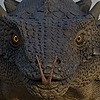HOME | DD
 VikasRao — Lameta formation
by-nc-sa
VikasRao — Lameta formation
by-nc-sa

#animals #dinosaurs #india #nature #rajasaurus #sauropod #sciart #snake #theropod #titanosaur #wildlife #lameta #sanajeh #jainosaurus #3dart #blender #cretaceous #evolution #paleoart #paleontology #prehistory #abelisauridae
Published: 2020-07-16 09:45:57 +0000 UTC; Views: 19333; Favourites: 389; Downloads: 0
Redirect to original
Description
Zoom in!
Madhya Pradesh, India, 67 mya, a herd of Jainosaurus septentrionalis defend their eggs from a pack of nest-raiders.
Jainosaurus (named after paleontologist Sohan Lal Jain) was a titanosaurian sauropod. At 16-18 m long, Jainosaurus was as long as a humpback whale, but this was mediocre by titanosaur standards, as larger species such as Argentinosaurus and Patagotitan were twice this size. Along with Isisaurus colberti, J. septentrionalis is among the best-known Late Cretaceous Indian sauropods, but isn’t depicted as often in paleoart, hence why I decided to illustrate it here.
Rajasaurus narmadensis (meaning “king lizard”) was a majungasaurine abelisaurid and among the largest and best known theropods from India. At 6.6 m long, it was half the size of T. rex, but was still a formidable predator, like the dinosaur equivalent of a bengal tiger. It shared its habitat with several other, less well-known, abelisaurs such as Indosaurus matleyi, Indosuchus raptorius and Rahiolisaurus gujaratensis, though there’s a possibility that at least some of them may be junior synonyms of each other or R. narmadensis. As with other majungasaurines, R. narmadensis was a heavily built animal that likely wasn’t particularly fast, unlike the South American Carnotaurus.
Known only from 3 cervical vertebrae Laevisuchus indicus (meaning “light crocodile”) was a much smaller theropod, around 2 m long. It was likely a mesopredator, like jackals and foxes today. Despite the fragmentary nature of its fossils, the vertebrae are very similar to those of noasaurids such as the well-known Masiakasaurus, and thus is classified as a basal member of the clade.
While the dinosaurs brawl it out, the early snake Sanajeh indicus sneaks into a nest undetected, having set its sights on a hatchling. It was about as large as a modern Indian rock python (Python molurus) at around 3.5 m. In 2010 a fossil was described of this snake coiled around an egg next to a sauropod hatchling, meaning it likely ate baby dinosaurs at nests, meaning it was a dinosaur-eating snake! It belonged to a clade of now extinct snakes called Madtsoiidae, the last of which died out at the end of the Pleistocene around 12,000 years ago. S. indicus didn’t have the wide gape characteristic of many modern snakes, and as such would have been limited to only swallowing small prey. In this regard, a dinosaur hatchling would have made for ideal prey.
Tools: Blender 2.83, Photoshop
Related content
Comments: 11

👍: 2 ⏩: 1

👍: 2 ⏩: 1

👍: 2 ⏩: 1

Looks awesome. I especially love the colors and the background you have for the whole picture. It just looks so nice.
👍: 2 ⏩: 1

👍: 2 ⏩: 1

You’re welcome. Be sure to watch me soon.
👍: 1 ⏩: 0

I always wondered why insular India was never that much featured in paleoart.
👍: 2 ⏩: 0

👍: 2 ⏩: 0

















